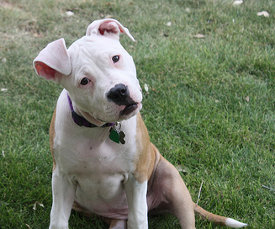
Humans and dogs don't speak the same language, which is a problem during training. Sometimes, your dog may give you a look like this dog has - "Huh?" To help you successfully communicate with your dog during training, try these recommended dog training tools. They'll speed up the process.
Squeak toys
Believe it or not, squeak toys are a fantastic tool for training. Hold one behind your back and squeak it to get your dog's attention. This is really useful when there are dogs or other distractions around. A quick squeak will get your dog's eyes on you.
Squeak toys are also a good way to teach your dog "drop it." Squeak it and hold it out for your dog to grab. After he takes it, say "drop it" and let go of the toy. Your dog will most likely be more interested in the toy when you're pulling on it, so letting go of the toy often leads to the dog dropping it and trying to get your attention. When your dog drops the toy after you say "drop it," reward him with praise or a treat. This command is really useful when walking in new areas - if your dog picks up an iffy object, you can say "drop it" so he's not getting into something he should avoid.
Suggested training tool: Plush Puppies Dog Toys. They're long, which makes them perfect for teaching "drop it" where you need a toy both you and your dog can hold at the same time. It has squeakers throughout the toy, making it easy for you to squeak it even while holding it behind your back.
Crates
The crate is one of the best training tools you can use. When your dog is a puppy, it's incredibly useful for housebreaking. A puppy will not soil the area he eats and sleeps in, so the crate teaches your dog to hold it until he is taken outside. Make sure you don't get a crate that is too large, otherwise you'll have a puppy that relieves himself in one corner and sleeps in another.
The crate is also useful in teaching your dog a safe place. Many dogs who grow up with a crate love it and see it as their safe den. You can also teach your dog to "go to crate," which tells him to go to his safe place when you need him in a secure location. This is handy if you have guests walking in the door and you don't want your dog jumping on them, getting underfoot, or running out the door. It's also useful for keeping your dog out of the way of repairmen, inside when you're bringing things in or out of the house, etc.
Suggested training tool: Midwest Crates. These crates include a divider panel, so you can make the crate smaller for a young puppy and provide more room as he grows.
Muzzles
For dogs who have a problem with nipping or chewing, a muzzle keeps them from getting into trouble. This is especially important for puppies. Puppies explore the world with their mouth, which is why they chew on your hands, your shoe laces, their toys, and anything else they can reach. If your house isn't puppy-proofed, this may include wires that have risk of shock, chemicals they find in cabinets, and other dangers around the house. Some dogs have issues around other dogs and are prone to snapping. While you're working on correcting this behavior, you may opt for a muzzle to keep them from injuring another dog. You should not leave your dog muzzled unsupervised, for extended periods of time, or as a substitute for training. Please use them responsibly.
Suggested training tool: Dog Muzzles For Chewing. These muzzles allow your dog to open his mouth, drink water, and pant while preventing him from chewing or biting. They're perfect for training as you can give your dog training treats to reward good behavior.
Harnesses
Is your dog a puller? Harnesses are very useful at controlling this behavior and teaching your dog to walk calmly on a leash. Harnesses go across the chest, rather than the throat. This prevents your dog from injuring his throat by pulling too hard. It also provides you greater control of your dog. A quick tug on the leash will still get his attention when he's wearing a harness. Unlike head collars that teach dogs not to pull, harnesses may be used on dogs as young as 8 weeks old. This allows you and your dog to form good habits early.
Suggested training tool: Dog Harness No Pull Set. This harness is specially designed to teach your dog not to pull and includes a leash.
Agility equipment
As they say, a tired dog is a good dog, so any way you can exercise your dog and provide mental stimulation is a good thing. Agility is a popular sport that strengthens the bond between dog and handler. Energetic dogs get to run, jump, climb, and crawl through an obstacle course. Competitions and clubs around the country provide a fun way to socialize and exercise your dog.
Suggested training tool: Agility courses for dogs. They're a complete set of equipment so you can practice in your backyard or at the dog park between meetings and competitions.
Dog training tools speed up the process of teaching your dog what behaviors you want. Use them to help your dog understand what is expected and you'll both be happier with training.
Want to get a discount on your first order from PawPosse.com? Join the Paw Posse and get a discount on these training tools.
If you liked this, you may also like:
Best Carpet Cleaner For Pet Stains - because sometimes accidents happen.
How To Get A Puppy To Stop Biting
How To Train A Dog To Walk On A Leash
Photo credit: Roy Montgomery
|